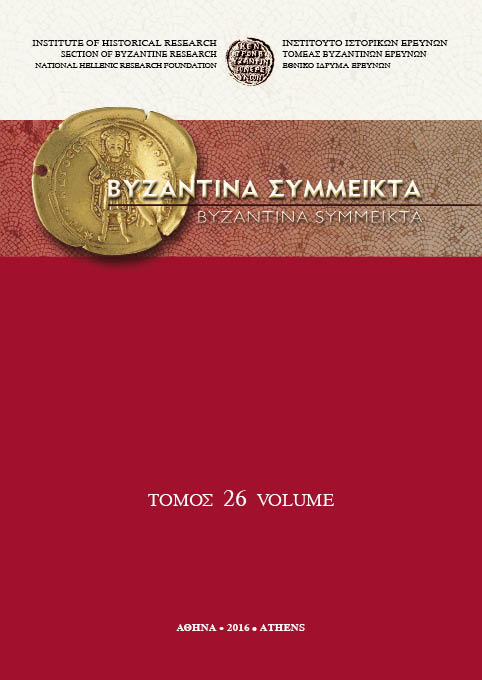Σχετικά με τα αίτα της εκθρόνισης του πατριάρχη Νικολάου Α' Μυστικού (907)

Abstract
Bassiliki N. Blyssidu
Über die Gründe der Absetzung des Patriarchen Nikolaos I. Mystikos (907)
In dieser Arbeit werden Ähnlichkeiten der politischen Tätigkeit des Photios mit jener des Nikolaos Mystikos während seines ersten Patriarchats erörtert. Die Anfänge der Einmischung des Nikolaos I. in die politischen Angelegenheiten des byzantinischen Reiches rufen ähnliche Taten seines Lehrers Photios zurück. Beide Patriarchen kamen den Drungariern der Flotten, Adrianos, und Eustathius energisch zur Hilfe, als sie als verantwortliche für den Fall von Syracus (878) und Taormina (902) von den jeweiligen Kaisern Basileios I. und Leon VI. beurteilt wurden.
In ihrem Versuch ihre Ansichten und politische Ziele durchzusetzen, zogen Photios und Nikolaos I. ausgewählte Vertreter der adeligen Spitze der Gesellschaft zusammen. Diese strebten unter der Führung von Kurkuas, Babutzikos, Andronikos Dux, die allerdings aus Paphlagonien stammten, nach der Niederwerfung des Basileios I. und Leons VI. Die Ähnlichkeiten in Bezug auf die Tätigkeit der beiden Patriarchen sind wesentlich und offensichtlich.
Durch die Absetzung des Nikolaos Mystikos, versuchte Leon VI. vielleicht auch nicht nur seine eigene Lösung in das berühmte 'Tetragamieproblem' durchzusetzen, sondern auch die Wiederholung einer Geschichte zu vermeiden, die jene des Photios erinnern würde.
Article Details
- How to Cite
-
ΒΛΥΣΙΔΟΥ Β. (1997). Σχετικά με τα αίτα της εκθρόνισης του πατριάρχη Νικολάου Α’ Μυστικού (907). Byzantina Symmeikta, 11, 23–36. https://doi.org/10.12681/byzsym.821
- Issue
- SYMMEIKTA 11
- Section
- Articles

This work is licensed under a Creative Commons Attribution-NonCommercial-ShareAlike 4.0 International License.
Copyright: The copyright for articles in this journal is retained by the author(s), with first publication rights granted to the journal. By virtue of their appearance in this open access journal, articles are free to use (with the exception of the non-granted right to make derivative works) with proper attribution for non-commercial uses (licence Creative Commons 4.0). NHRF retains the worldwide right to reproduce, display, distribute, and use articles published in BYZANTINA SYMMEIKTA in all formats and media, either separately or as part of collective works for the full term of copyright. This includes but is not limited to the right to publish articles in an issue of the Journal, copy and distribute individual reprints of the articles, authorize reproduction of articles in their entirety in another NHRF publication, and authorize reproduction and distribution of articles or abstracts thereof by means of computerized retrieval systems.








